Tutorial FreeCAD POV ray
| Topic |
|---|
| Rendering |
| Level |
| Intermediate |
| Time to complete |
| 60 minutes |
| Authors |
| vocx |
| FreeCAD version |
| 0.18 or greater |
| Example files |
| none |
| See also |
| None |
Introduction
This tutorial shows how to produce a rendered image in FreeCAD, using the POV-ray renderer. It assumes that the user already created a part or assembly in FreeCAD, or has imported one into it. It uses the Raytracing Workbench to produce the file for rendering.
This tutorial is based on the forum post by schupin FreeCAD / pov ray tutorial, which also includes the files required to produce the model and the rendering.
Basic setup
Follow the basic workflow outlined in the Raytracing Workbench documentation.
For direct rendering to work, the povray executable must be set in Edit → Preferences → Raytracing → Render → POV-Ray executable; set it to its location in your system, for example, /usr/bin/povray. Other options used by the renderer can be defined here as well, including the width +W and height +H of the image.
Setup the .pov file
1. Create an assembly using bodies from the Part or PartDesign Workbenches, or any other workbench that produces solid objects, for example, the Arch Workbench. Assign colors or materials to the individual bodies that make the assembly, approximately matching the color that you want in your render.
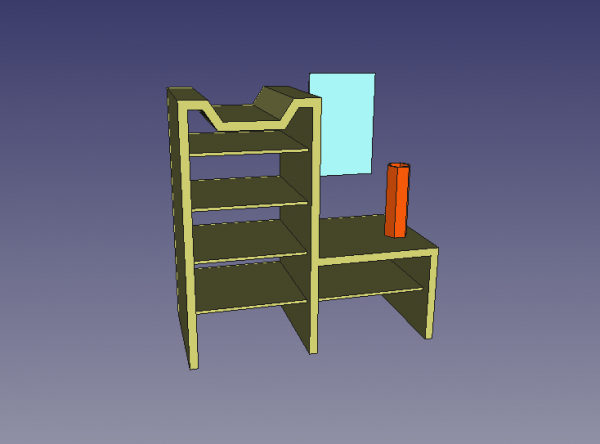
Assembly of three bodies created in FreeCAD, and with colors or materials assigned.
2. If your model is very detailed, make sure the ViewDeviation of the body is set to a low value, between 0.1 and 0.01, or even smaller. The lower this value is, the more detailed the exported mesh will be, and thus the better the quality of the render will be.
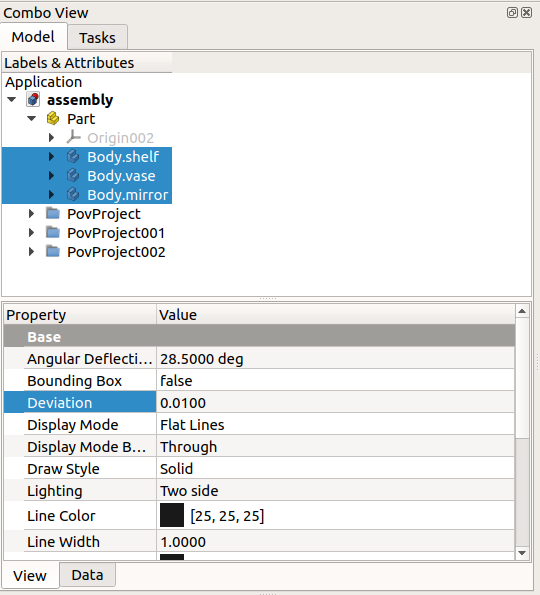
Deviation property of the bodies created in FreeCAD; the deviation needs to be small in order to export the parts with good resolution.
3. Create a POV-ray project by clicking New. If the viewport is set as orthographic, change it to perspective, as the renderer will work with a camera with perspective view. Using perspective view will allow you to see better what type of image will be actually rendered.
4. Select all the objects that you want to add to your scene, then select the created PovProject object, and click on InsertPart.
Note: beware of those objects that are not currently visible in the 3D viewport. If they are invisible but are included in the scene, they will still have an effect on light bounces, reflections, and shadows. On the other hand, if you really want to omit a body from being rendered, don't select it for inclusion into the POV-ray project.
Note 2: all objects in the POV-ray project will have a name based on their internal FreeCAD name. It's important to note which is the POV-ray name, as further options, for example, the material properties, will be assigned to these POV-ray names.
5. In the 3D viewport, zoom, pan and rotate the view to setup the scene that you want to render, that is, make sure the objects are centered in the viewport as much as possible; then select the created PovProject object, and press ResetCamera.
6. The POV-ray file is now ready; it contains all the selected objects and the camera information. Select the created PovProject object, and then press ExportProject to save the
.pov file.
7. The created .pov file can now be rendered directly from FreeCAD. Select the created PovProject object, then press Render, and give the file a name. When the popup image appears on screen, click on it so that it is sent to FreeCAD in its own window tab.
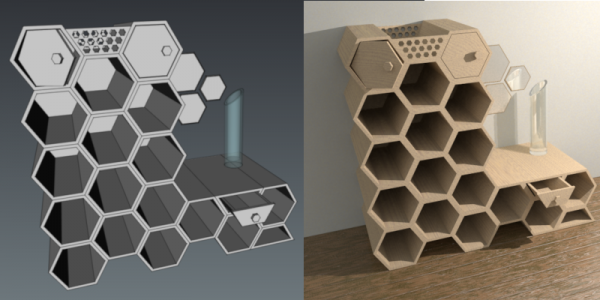
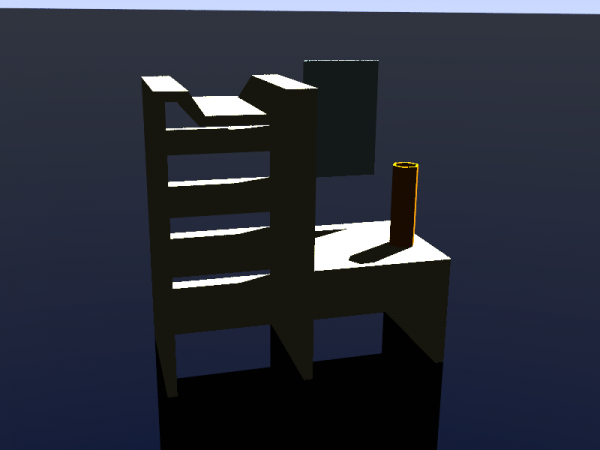
First render of the assembly produced with povray, with the standard template project file written by the Raytracing Workbench.
8.1. With the .pov file already created, it is possible to run the the povray executable from the command line.
povray assembly.pov +w800 +h600
The command line options +wX +hY set the horizontal and vertical sizes of the final image.
The command line options +a and +am2 are useful to trigger antialiasing to produce a smoother image.
8.2. By double clicking the PovProject object it's possible to see that it is using the ProjectStd.pov template; this template creates a basic .pov file which will produce a simple and dark image.
To improve the appearance of the image, use a better template. Double click the PovProject object and choose the RadiosityNormal.pov template. Then export a new .pov file, and run again the renderer. The image should look brighter and generally better.
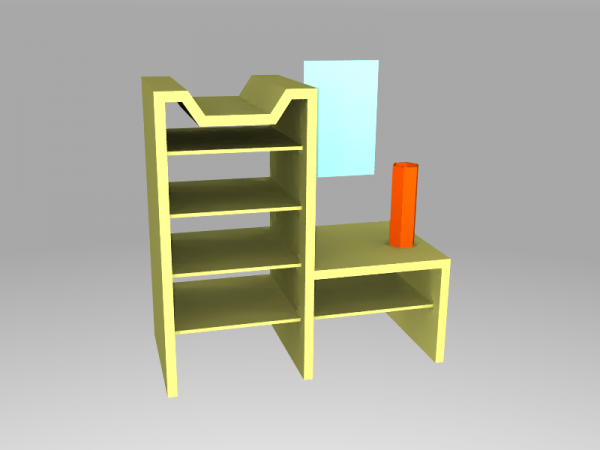
Render of the assembly produced with povray, with the RadiosityNormal template written by the Raytracing Workbench.
Once again double click the PovProject object and now choose the RadiosityOutdoorHQ.pov template. Then export a new .pov file, and run again the renderer. The image should take a bit longer to produce, but the resulting image should have better quality.
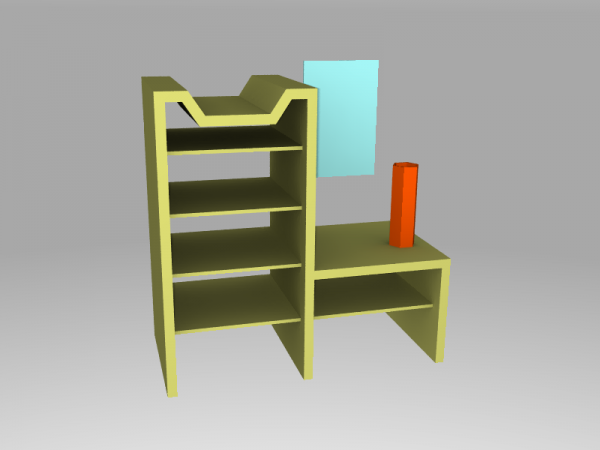
Render of the assembly produced with povray, with the RadiosityOutdoorHQ template written by the Raytracing Workbench.
If the rendered images are good enough, then there is nothing more to do. However, in order to control precisely the appearance of the materials and produce even better results, the .pov file needs to be edited manually.
In the following sections, we edit the basic .pov file produced with the standard template.
Editing the .pov file
6. The .pov file generated by FreeCAD is a simple text file that can be opened with any editor. It loosely resembles a C++ source code file: directives start with a hash # and are terminated by a semi-colon ;. Control structures are enclosed in curly braces { }, and indentation is arbitrary whitespace. The lines that start with a double slash // represent comments that are ignored by the renderer.
The file may look complicated at first but 90% of its content is just mesh data that doesn't require much changes, as these meshes represent the solid bodies that we want to render.
The file is structured as follows:
- Global settings
- Sky sphere
- Plane
- Finishes and textures
- Camera
- Mesh and body information
- Light source
The camera information will not be touched, neither most information in the meshes. The main modifications will be made on the other sections.
As the meshes won't be heavily modified, the file can be re-organized so this information is at the end of the file.
Basic re-organization
7. Open the .pov file with a text editor, go to the end of the file, select and cut the light_source section, and paste it before the first //face number1 line or similar.
The resulting file should have the camera and light_source sections next to each other, for example
// Persistence of Vision Ray Tracer Scene Description File
// for FreeCAD (http://www.freecadweb.org)
#version 3.6;
.
.
.
// Generated by FreeCAD (http://www.freecadweb.org/)
#declare cam_location = <-171.753,1229.11,-2667.08>;
#declare cam_look_at = <636.959,359.955,160.296>;
#declare cam_sky = <0.068217,0.958943,0.275273>;
#declare cam_angle = 45;
camera {
location cam_location
look_at cam_look_at
sky cam_sky
angle cam_angle
right x*800/600
}
//default light
light_source {
cam_location + cam_angle * 100
color rgb <10, 10, 10>
}
// Written by FreeCAD http://www.freecadweb.org/
// face number1 +++++++++++++++++++++++++++++++++++++++++++++++++++++++++++++++++++++
.
.
.
Prepare the body textures
8. The textures of each body need to be adjusted. This is the most time-consuming job of this process.
A body mesh is defined by faces, and each face is defined by a series of triangular elements that themselves are defined by vertex vectors, normal vectors, and face indices. This information doesn't need to be modified at all. Then, each body is defined as the union of the specified faces. Again, this information doesn't need modification.
Finally, each object to be rendered is defined as one of the specified bodies, with a particular texture, which itself can have some default properties like pigment and finish.
// instance to render
object {Pov_Body
texture {
pigment {color rgb <0.827451,0.827451,0.431373>}
finish {StdFinish } //definition on top of the project
}
}
By searching for the keyword object, it's possible to go directly to the desired part in the file, and change its texture appropriately.
As indicated in the comment, the definition of the StdFinish value is at the top of the file, in this case before the camera information. The finish is comprised of a declaration that can have many different properties, as shown in the commented and uncommented lines.
// Standard finish
//#declare StdFinish = F_MetalA;
//#declare StdFinish = finish { diffuse 0.7 };
//#declare StdFinish = finish { phong 0.5 };
//#declare StdFinish = finish { ambient rgb <0.5,0.5,0.5> };
//#declare StdFinish = finish { crand 0.5 phong 0.9};
#declare StdFinish = finish { ambient 0.01 diffuse 0.9 phong 1.0 phong_size 70 metallic brilliance 1.5} ;
A texture is a general container that describes a material; it includes information like the pigment (color), normal (how the color changes with the curvature of the surface), finish (interaction of the surface with the light), patterns (checker, agate, spiral, radial, wood, etc.), and other properties. There are many options that can be combined together to produce a working texture. This mixing is not trivial, but there are many examples online to obtain the desired appearance of a material.
POV-ray comes with an extensive library of materials that can be readily used by name. By default, the project file makes available some materials by using #include statements at the beginning of the file. These materials can be included by name and further modified as desired.
#include "colors.inc"
#include "metals.inc"
For example, a silver texture is already defined in the metal.inc library, and can be readily used in a defined Tsilver texture.
#include "metals.inc"
#declare Tsilver = texture{ T_Silver_5E }
In the following example, the woods.inc library is imported; this defines a T_wood7 texture that is then modified with scale, translation, and finish.
#include "woods.inc"
#declare Twood = texture {
T_Wood7
scale 50.0
translate x*1
translate y*10
finish { ambient 0.01 diffuse 0.9 phong 1.0 phong_size 70 brilliance 0.5} ;
}
Prepare planes
9. Planes are useful to serve as a floor or table top on which the model is standing. More planes can be added to serve as walls or other shapes, in order to obtain the right conditions of rendering.
By default, the project file defines a single plane, 1 millimeter below the model, that is slightly reflective.
plane {
y, -1
texture { pigment {rgb <0.0,0.0,0.0>} finish {ambient 0.0 reflection 0.05 specular 0.0} }
}
Beware that when adding planes, in POV-ray the X axis is defined as horizontal (left-right), the Y axis is defined as vertical (up-down), and the Z axis is defined as depth (front-rear).
Prepare lights
10. By default, the project file defines one light with a position and color.
//default light
light_source {
cam_location + cam_angle * 100
color rgb <10, 10, 10>
}
Like other objects, it can be modified with many options, including things like fade_distance, area_light, and jitter.
Prepare the global settings, radiosity
11. The global settings define ambient light.
global_settings {
assumed_gamma 1.0
ambient_light color rgb <1.0,1.0,1.0>
max_trace_level 20
}
The radiosity property inside the global_settings controls the way POV-ray computes the light interactions with the objects. It's essential to thinker this property to obtain good results.
Because it can be time consuming to test different settings you can use a variable and a #switch statement to quickly use low, medium or high quality render settings.
#declare Rad_Quality = 3;
global_settings {
assumed_gamma 1.0
max_trace_level 10
#switch (Rad_Quality)
#case (1)
radiosity { // --- Settings 1 (fast) ---
pretrace_start 0.08
pretrace_end 0.02
count 50
error_bound 0.5
recursion_limit 1
}
#break
#case (2)
radiosity { // --- Settings 2 (medium quality) ---
pretrace_start 0.08
pretrace_end 0.01
count 120
error_bound 0.25
recursion_limit 1
}
#break
#case (3)
radiosity { // --- Settings 3 (high quality) ---
pretrace_start 0.08
pretrace_end 0.005
count 400
error_bound 0.1
recursion_limit 2
}
#break
#end
}
Final structure
12. The edited .pov file can be saved when all adjustments have been done.
The final structure is as follows:
- Global settings, with radiosity parameters
- Sky sphere
- Planes, positioned as desired
- Finishes and textures, with custom texture definitions
- Camera
- Light source, with some additional properties
- Mesh and body information, using the textures defined previously
Note: the sections of the .pov file can be in any order, although it is probably easier to work with it if the mesh information is left to the end.
Final render
13. The final rendering can be done by clicking Render.
povray assembly.pov +w800 +h600 +a

Final render of the assembly produced with povray, with the edited .pov file initially written by the Raytracing Workbench.
Final notes
POV-ray is a relatively old piece of software; its main advantage is that it is a tested solution whose properties are set only by a text file. Also, the renderer is available from the command line in many operating systems, and it runs in old hardware.
The user is advised to read more documentation and tutorials on POV-ray in order to set up the right settings for his or her needs.
- Getting started
- Installation: Download, Windows, Linux, Mac, Additional components, Docker, AppImage, Ubuntu Snap
- Basics: About FreeCAD, Interface, Mouse navigation, Selection methods, Object name, Preferences, Workbenches, Document structure, Properties, Help FreeCAD, Donate
- Help: Tutorials, Video tutorials
- Workbenches: Std Base, Arch, Assembly, CAM, Draft, FEM, Inspection, Mesh, OpenSCAD, Part, PartDesign, Points, Reverse Engineering, Robot, Sketcher, Spreadsheet, Surface, TechDraw, Test Framework
- Hubs: User hub, Power users hub, Developer hub